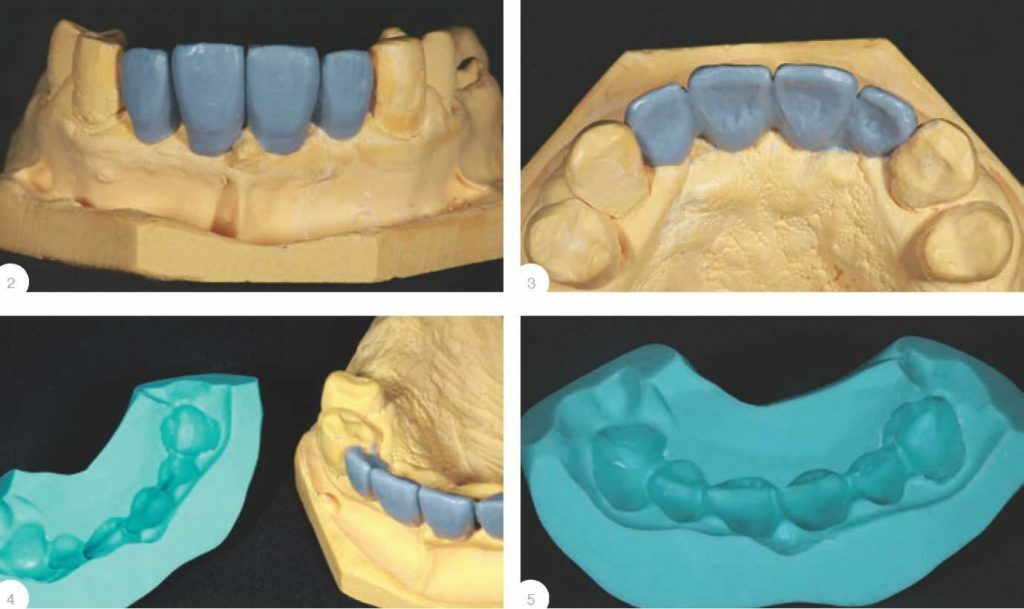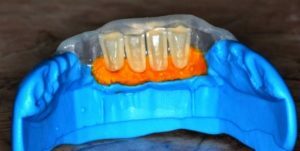 The development of modern restoration methods enables the functional and aesthetic restoration of teeth. One of such methods is the technology of using a silicone key.
The development of modern restoration methods enables the functional and aesthetic restoration of teeth. One of such methods is the technology of using a silicone key.
Silicone key in dentistry is a technique for restoring the anatomical shape of teeth using silicone prints. Such keys are made using a model of gypsum. The defect is restored with wax.
An occlusal silicone key is used to accurately repeat the shape of the anatomy. This is especially true for the palatine surface. The template is used for the restoration of both frontal and lateral molars. To obtain the most reliable copy, the template should cover the gum area and the adjacent teeth. 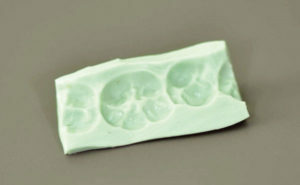
The template is made of A-silicone directly in the oral cavity, the impression is taken off, while the cutting edge of the restored tooth and the two adjacent sides for the reliability of the support are grasped. The resulting impression is cut along the line, which forms the cutting edge.
Contents
- Features of restoration
- Indications and contraindications
- Advantages and disadvantages of
- technique Teeth restoration phases
- Price
Features of restoration
The method of silicone key in therapeutic dentistry is an innovative development that allows to provide the maximum aesthetic appearance and anatomical shape of the restored tooth. This technique significantly reduces the time spent on restoration.
This technology is also used to eliminate caries of latent forms characteristic of molars of the chewing group. The carious cavity is filled with a composite material, and the final portion is modeled by a template. In this case, in order to exclude the material flow, the drain channels in the key are created.
You can also make a cast without using a spoon. The restoration procedure can be performed in several stages with layered application of the material. Instructions for using a silicone key in dentistry can be found in the video.
Indications and contraindications
The indications for the use of a silicone key are such patient conditions:
- recovery after injury in the form of chips;
- need to replace old seals;
- treatment of caries in the primary stages;
- need for aesthetic restoration.
Since the materials of the silicone group are used, some patients may develop allergic reactions to them. Such cases are contraindications to the use of technology of the silicone template.
Advantages and disadvantages of the
technology The technology of the silicone template( key) allows to achieve such results:
- significant saving in time for restoration;
- palatine surface optimally corresponds to the natural, the occlusal plane is almost natural and is suitable for the patient( at the final stage of recovery, some adjustment is required on the clamping points of the teeth);
- absolute symmetry along the contour between the cutting edges of the canines and incisors;
- controllability of the process of applying composite materials and, as a result, the optimum thickness, which requires minimal finishing.
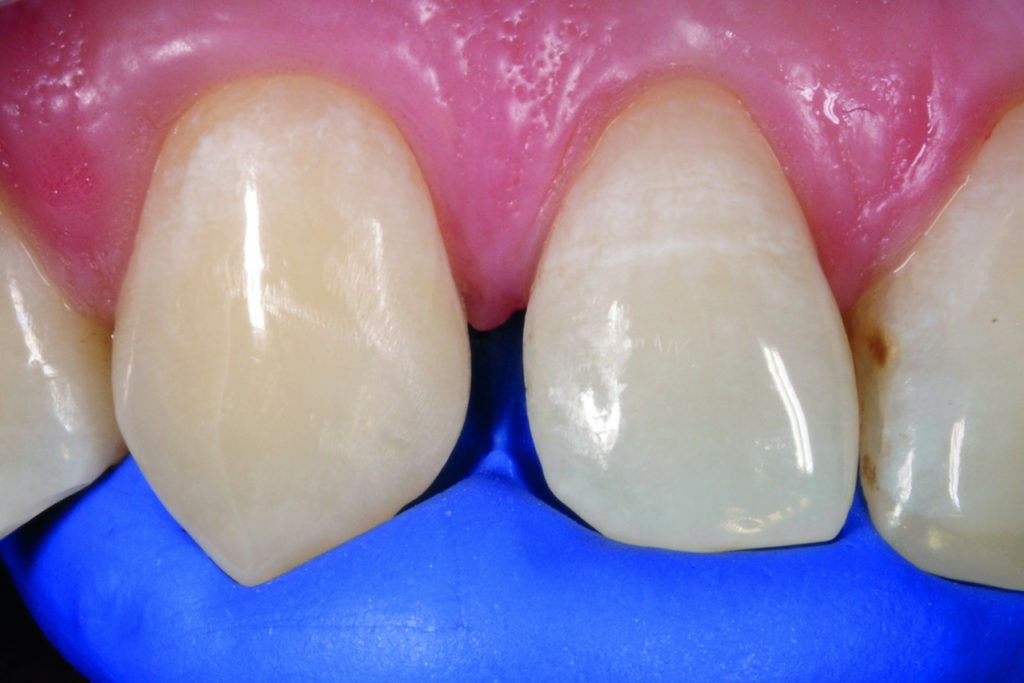
There were some drawbacks. These include the following factors:
- silicone refers to rigid materials, which does not allow full-scale representation of micro anatomy;
- silicone is susceptible to deformation when pressing composite materials;
- work is limited to a single-track execution technique;
- the use of latex fabric makes it difficult to work with a silicone block.
The latest developments use a carrier( applicator) and fluid-flow composite materials, which allows you to get as close to the anatomical structure when removing impressions.
Teeth restoration phases
Teeth restoration using silicone template technology is performed in the following order:
- Color definition .At the first stage it is necessary to determine the color of the restored cutter, molar.
- Modeling of the form. Wax is used, and the tooth is repeated on the model in shape. The extracted model serves as the basis for manufacturing the silicone template. This technique for dentists is called Wax-up.
- Mock-up .Direct modeling of the anatomical shape of the teeth in the oral cavity.
- Key manufacture .The removed silicone impression serves as a basis for manufacturing a template from silicone of the surface of the palate.
- Dissection of .When using the Mock-up technique, composite materials are extracted from the oral cavity beforehand, then the cavity is carved with the caries. In cases of need for the purpose of aesthetic restoration, pigmented tissues are removed from the surface of the enamel. To ensure a smooth color transition between artificial and natural tissues, the dentist forms a bevel of the enamel surface.
- Cleaning .With the help of abrasive pastes and special tools( nozzle in the form of a brush), teeth are cleaned.
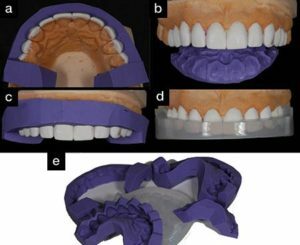
- Etching .For etching and applying adhesive material, it is necessary to ensure reliable protection of teeth from contact with saliva secretions.
- Securing the key. A composite material is applied to the silicone matrix( cutting edge).The finished silicone template is fixed on the tooth surface on the palatine side. Then the base shade of enamel is applied. The process is performed from the palatine surface. Thus, the template specifies a form for further compositing in several layers.
- Applying the basic shade of the enamel .To form a dental aproximal surface, you need to install a special matrix. After this, the dentist applies a basic shade of enamel.
- Application of dentin .At the next stage, a layered application of the dentine surface occurs. Restoration is performed in the direction from the oral to the vestibular surface.
- Overlay of the color. The application of the required color tone of the enamel completes the restoration stage.
- Hardening and stripping .The resulting enamel is dried to hardness and then mechanical stripping is performed.
- Polishing .At the final stage, the surface is polished using special silicone attachments at low speed.
As a result, the patient after all manipulations has a restored incisor practically not different in anatomy and color.
The cost of
The pricing policy differs and depends on many factors. The raw materials, equipment with technological equipment, the level of personnel qualification affect the price level when restoring teeth according to the occlusal key technique. Private clinics will offer patients a quality service level, but the prices will be higher than when applying to state polyclinics.
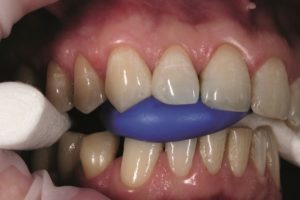 The cost also depends on the number of units to be restored. To find out all information about price lists for services provided, you can directly contact the websites and call the medical institutions.
The cost also depends on the number of units to be restored. To find out all information about price lists for services provided, you can directly contact the websites and call the medical institutions.
Teeth restoration using the silicone key technique refers to invasive technologies. This technique allows you to restore the functionality of the teeth with minimal time.
Cured and restored in this way the teeth do not differ from the present, serve for a long time. Aesthetic restoration allows you to correct defects, shape, color, etc. The patient spends less time compared with traditional methods of restoration of the dentition.

